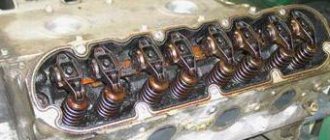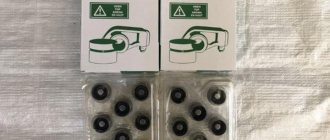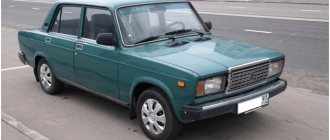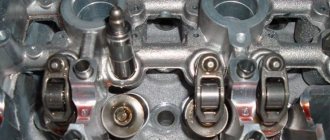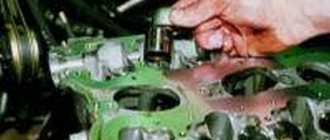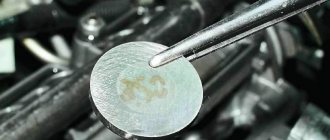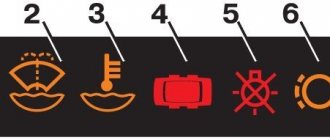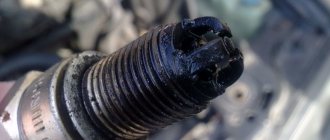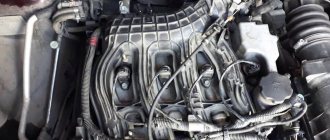Design and operating principle
The design of the hydraulic compensator itself is simple.
It consists of a cylindrical piston, the bottom of which receives the force from the camshaft cam. Inside this piston, a plunger is installed in its seat, through which force is transmitted through the piston from the cam to the valve stem (see photo above).
The plunger moves freely in its seat, providing a thermal gap.
The hydraulic valve works like this: when the engine is running, the cam runs up against the bottom of the hydraulic compensator piston and moves it down. While moving, the piston presses on the valve through a plunger, and it opens.
The oil pump supplies working fluid to the head under pressure. In the hydraulics, it enters the space below the plunger and displaces the plunger inside the seat.
The higher the oil pressure, the more it will put pressure on the plunger and the more it will come out of its seat.
When the pressure decreases, the plunger enters the seat again. Thus, the thermal gap between the plunger and the valve stem is independently regulated and depends on the pressure in the lubrication system.
To prevent oil from flowing out of the hydraulic valve after stopping the engine, ball valves are installed in the oil supply channels in the cylinder head.
Having the advantage of no need for adjustment, the hydraulic compensator also has one significant drawback - high sensitivity to engine oil.
Camshaft location
Modern cars most often use a mechanism with an overhead camshaft, which has reduced the metal consumption of the structure and, as a result, increased reliability.
Since metal expands when heated, and the valves are constantly in a high-temperature zone, to prevent it from being pressed in, as a result of which it does not fit tightly into the seat, a thermal gap is provided between the valve stem and the camshaft cam.
In this case, the thermal gap has a certain value to ensure the maximum possible opening of the valve, eliminating its tightening.
Previously, on engines with an overhead camshaft, the thermal clearance was adjusted by placing shims of a certain thickness between the valve stem and the camshaft cam.
The disadvantage of using these washers was the need to periodically check the gap and adjust it by selecting washers.
Nowadays, to ensure thermal clearance, hydraulic compensators are increasingly being used, popularly known as hydraulic compensators, the use of which eliminated the need to adjust the gap, and all because the gap is adjusted by oil pressure.
Hydraulic compensators, like shims, are located between the valve stem and the camshaft cam.
Externally, the hydraulics look like a small piston, so the head has seats for them.
Identifying faulty hydraulic compensators
In principle, it is not difficult to identify a knocking hydraulic compensator. It is enough to remove the valve cover from the car to gain partial access to them, which will be enough for checking.
To check the hydraulics, it is enough to use a thin wooden block.
The check is carried out by pressing on the bottom of the hydraulic valve. When force is created, it will begin to sink into its seat. When checking, it is important that the camshaft cam does not act on the bottom of the hydraulic valve.
A jammed hydraulic compensator will simply not be recessed into the seat by the created force; human impact will not be enough to overcome the forces of the valve spring.
If there is no oil in it for any of the listed reasons, the hydraulic valve will be recessed into the seat with significantly less force than when working normally.
POPULAR WITH READERS: Different compression in cylinders, what to do
Using this method, you can calculate broken hydraulic compensators.
Reasons for knocking of hydraulic compensators when hot
In most cases, there may be one of two reasons why hydraulic compensators knock when hot - the viscosity of the heated oil is too low or its pressure is insufficient. This can occur for various reasons.
- Low oil level . This is a very common reason why hydraulic compensators knock when hot. If there is not enough lubricating fluid in the crankcase, then there is a high probability that the hydraulic compensators will operate “dry”, without oil, and, accordingly, will knock. However, overfilling oil is also harmful for hydraulic compensators. In this case, foaming of the lubricating fluid occurs, which leads to airing of the system, and as a result, incorrect operation of the hydraulic compensators.
- Clogged oil filter . If this element has not been changed for a long time, then over time a coating of dirt forms in it, which prevents the normal movement of oil through the system.
- Incorrectly selected viscosity . Car enthusiasts are often interested in the question of why hydraulic compensators knock when hot after an oil change . In most cases, the problem is precisely due to an incorrectly selected oil viscosity or it turned out to be of poor quality. It’s not that hydraulic compensators like some oil and some don’t, you just need to choose it correctly. If the oil is too thin, there may not be enough pressure to completely fill the hydraulic fluid. And when it is of poor quality, it simply quickly loses its performance properties. Changing the oil will help solve the problem, and do not forget that the oil filter needs to be changed along with the oil.
- Faulty oil pump . As a rule, this reason is typical for cars with high mileage, in which the pump has simply worn out and is not able to create the proper pressure in the engine lubrication system.
- Use of oil additives . Most oil additives perform two functions - they change the viscosity of the oil (lower or increase it), and also change the operating temperature of the oil. In the first case, if the additive has lowered the viscosity of the oil, and the hydraulic compensators are already quite worn out, then conditions arise when the hydraulic valves knock on a hot engine. As for the temperature regime, the oil works optimally when it’s hot, and an additive can change this property. Accordingly, after pouring the additive into the oil, the hydraulic compensators may knock when there is not enough pressure to push the oil into them. Usually due to too thin oil.
- Problems in the plunger pair . With such a malfunction, oil leaks from the cavity under the plunger, namely between the plunger bushing and the plunger itself. As a result, the hydraulic compensator does not have time to select the working gap. This breakdown may occur due to wear or clogging of the ball valve in the plunger pair. The ball itself, the spring, and the working cavity (channel) may wear out. If this happens, then only replacing the hydraulic compensators will help.
This is interesting: What to do if the battery light on the instrument panel is on
Hot
Sometimes owners notice how hydraulic compensators begin to knock when hot when the engine is brought to operating temperature. There are also three reasons.
- The plunger pair of the hydraulic compensator is jammed. Loss of performance occurs due to dirt or natural wear and tear. Due to the appearance of scoring, the plunger stops moving fully. The thermal gap cannot be adjusted, so the hydraulic compensator begins to knock.
- Insufficient viscosity of oil heated to engine temperature. It begins to seep through the gaps of the plunger pair faster than when supplied by an oil pump. Lubricant from an unknown manufacturer, or incorrect selection taking into account the manufacturer’s recommendations leads to severe liquefaction. Leakage occurs along technological gaps.
- Exceeding the recommended engine oil level. This causes it to foam as the crankshaft forces the lubricant to circulate. This process is enhanced when water enters the engine. The driver needs to check the oil level. If possible, it is worth installing a new filter, first adding new lubricant.
In the cold
The knocking sound of the engine can appear on a cold engine and disappear as the engine warms up. Then the most likely reason is a clogged oil channel. After warming up, the oil will become more liquid and the knocking will stop. But over time, the channels will definitely become completely clogged, and then the knocking will be continuous. Here you can use special additives - they will help clean the channels from accumulated contaminants.
The knocking of hydraulic compensators when cold is also due to a decrease in the throughput of the oil filter. Then knocking with varying intensity will be heard until the engine is completely warmed up.
Pay attention to the hydraulic compensator valve - if it does not hold oil, liquid will leak out when the engine is turned off.
Thus, air enters the system, which is forced out after starting the engine - the knocking disappears. Wait 5-7 minutes. Sometimes it is useful to rev the idle speed - this will increase the pressure in the oil supply system. But it is harmful to gas for a long time. It is better to do this only when the warmed-up engine has been stopped for a while.
Why do new hydraulic compensators knock?
The problem does not always go away after replacing hydraulic compensators. Especially if the engine has new elements installed and fresh oil is added. There are several options.
- Incorrect oil selected.
- The old filter is too clogged, you need to install a new one instead.
- The cleanliness of the lubrication system leaves much to be desired.
- The oil pump has failed.
- Oil supply channels are clogged.
As a rule, knocking has to be treated by flushing the cylinder head. If this does not help, then you need to replace the new oil pump. This behavior indicates significant natural wear and tear. Troubleshooting in this way is a rare occurrence, because in 90% of cases the problem is eliminated after changing the selected oil and washing the hydraulic compensators.
This is interesting: How and how to fix a leaking car radiator
Restoration and repair of hydraulic compensator
How to restore the hydraulic compensator?
Not every expansion joint can be repaired, but sometimes replacement can be delayed. This is especially true in cases where it is not possible to buy a hydraulic compensator of a suitable type from a catalogue. There are at least three ways to restore the pusher:
- Washing with a special composition. The best composition for washing hydraulic compensators is considered to be Liqui Moly Hydro-Stossel-Additiv. Its price is about $12, it will help flush the compensator channels and the oil channels of the cylinder head. It is used to flush the lubrication system with both new oil and old (preferably): pour 300 ml (per 6 liters of oil) Liqui Moly Hydro-Stossel-Additiv into the engine, after a run of 700-1000 km, drain and change the oil and filter . If the problem is coking of the channels, it helps in 90% of cases.
Liqui Moly Hydro-Stossel-Additiv, use at your own peril and risk - Flushing the lubrication system using the standard method when changing oil and filter. Not everyone likes flushing compounds, so whether to use this method or not is a matter of conviction.
The best option is mechanical manual cleaning and washing - Mechanical cleaning works most effectively . Yes, we will have to remove and disassemble, clean and rinse the hydraulics, but we will be 100% sure of the result and will not poison the engine with chemicals, we love our car, right?
Keep an eye on the condition of the hydraulic lifters and your engine will run for hundreds of thousands of miles without problems.
Interesting on the topic: Our Lanos: changing the timing belt
Signs of knocking hydraulic compensators when hot
It is very important for a car enthusiast to know how to understand that one or more hydraulic compensators are knocking. After all, its knocking can easily be confused with other sounds due to problems with the piston pin, crankshaft liners, camshaft or other parts inside the engine.
The knocking of hydraulic compensators when hot can be diagnosed by opening the hood. The sounds will start coming from under the valve cover. The tonality of the sound is specific, characteristic of metal parts hitting each other. Some compare it to the sound of a chirping grasshopper. What is typical is that knocking from faulty compensators occurs twice as often as the engine speed. Accordingly, when the engine speed increases or decreases, the knocking sound from the hydraulics will behave accordingly. When you release the gas, you will hear sounds as if your valves are not adjusted.
How to recognize
The engine itself is a noisy unit, how can you determine that it is the hydraulic compensator that is knocking? If the compensator malfunctions, a sharp knocking or chirping sound appears. The frequency of which is half the speed of the motor.
A knock is considered a malfunction when it does not disappear after two to three minutes after starting the engine. Either it appears hot, after
warming up the engine. It may not be heard from inside the car, but you will hear it when you are outside the car, without even opening the hood.
What is the danger of knocking? This is the first sign of gas distribution problems.
The knocking may be due to a damaged valve spring, or due to excessively large valve clearances. Therefore the following check needs to be done:
- Inspect the condition of the springs (if they are broken) and check the dimensions of the valve clearances.
- If necessary, adjust the gaps.
- After this, you should turn the crankshaft so that the valve suspected of knocking opens slightly.
- Now turn the spring slightly, the valve will turn automatically behind it.
- Start the engine, the knocking noise may disappear.
- If not, try checking and adjusting the gaps again.
A persistent knock after such an adjustment means that the hydraulic compensator is broken.
Hydraulic compensators are knocking, is it possible to drive?
When there are knocking noises from the hydraulic lifters, you can drive, but this can lead to more expensive repairs than finding and eliminating the cause of the knocking.
Operating a vehicle with knocking hydraulic compensators will be accompanied by the following consequences:
- Reducing engine power.
- Uncomfortable driving in general. (Driving when something is knocking in the structure of the vehicle is not entirely pleasant for those who take care of their car).
- Increased level of environmental pollution.
- Excessive fuel consumption.
- Increased vibration.
Many people say that you can drive with tapping hydraulic compensators, but you need to understand that these parts are part of the engine design. And engine overhauls are much more expensive in both time and finances.
Causes
Let's look at the reasons why hydraulic compensators start knocking. This is a clear sign that not everything is fine with the car, there is a malfunction.
The key reasons are:
- contamination of the HA itself;
- mechanical wear has formed on the plunger pair;
- the valve responsible for the oil supply is not working correctly;
- bad or inappropriate oil was poured into the engine;
- oil filter clogged;
- oil channels are clogged;
- the engine heats up too quickly;
- air bubbles have appeared in the oil, negatively affecting the compressibility of the liquid;
- air got into the hydraulic compensators.
You should not think that if there is a breakdown in an engine with 8 or 16 valves, all compensators will start ringing at the same time. No. Only one detail is affected. But it is important to find out during the proceedings which one specifically. This requires diagnostics.
Advice from me personally. If you hear a knock, it is better to go to a service station. At least for professional diagnostics. Having modern equipment works wonders.
The test is carried out on hot and, let's say, cold. That is, when the power unit has cooled down and warmed up. And the reasons for knocking are different:
- If the knocking is cold, the problem is most likely in the viscosity of the oil (if the oil has not been changed for a long time, I advise you to do so). Also, when cold, expansion joints knock due to poor operation of the element valve. This leads to oil leakage when the engine is not running. It may be at the wrong temperature, poor quality, or a composition that is not suitable for the machine.
- A hot test also shows that the cause of the malfunction may be oil, a dirty filter and clogged channels. At the same time, there are several other reasons that can only be detected with such diagnostics using the hot method. We are talking about a faulty pump (oil), a hydraulic component of the main hydraulic system, or an increase in the landing location of these parts.
Only in some cases can you independently identify the cause. Therefore, it is better to contact a good car service center.
We recommend: Vehicle intake system
The main task of diagnostics is to find a hydraulic compensator that produces extraneous noise. For this purpose, the acoustic diagnostic method is used. In garage conditions, the chances of achieving results are, alas, minimal.
What to do if hydraulic lifters are knocking
If hydraulic compensators start knocking, what should you do in this case? There are two ways to solve the problem - complete replacement of the kit or repair of defective units. Let's consider each of them separately.
Replacement
The advantage of replacement is a guarantee of a good result. There are two disadvantages. A set of original catalog parts will be expensive. It is unlikely that you will be able to install it correctly yourself, so the car will have to be sent to a service center. Here you will also have to wait two or three days.
It must be taken into account that some foreign-made machines are subject to a shortage of parts. You have to wait for the complete set to arrive, spend money on postage, and make an appointment for repairs at a service center. For proper installation, you will also have to allocate some money for disposable parts - sealant and gaskets.
If the case is neglected and the driver does not try to take action to restore normal operation of the engine, the consequences can be dire. At first, when starting up, the knocking noise gets stronger over time. Then the smooth idle speed disappears. Since the thermal gap is not adjusted properly, it becomes more difficult to gain momentum each time. Ultimately, the entire valve mechanism wears out, and engine repair becomes inevitable.
Repair
To quickly troubleshoot the problem, you must first find out which compensator is starting to knock. Repair is possible if the malfunction begins to manifest itself when cold. With regular use of high-quality lubricant, with timely replacement, you just need to buy original oil, change the filter and check the result again. Most likely, the owner, without realizing it, bought a fake canister.
At the initial stage, it is worth buying flushing oil. Along with it you will have to acquire two filters. One is used when pouring flushing material, the other must be screwed on when the technical fluid has had time to circulate through the system in 15-20 minutes of idle operation. For special cases, you will need an aggressive composition. For example, pharmaceutical dimexide. Its chemical structure contains hard elements that are capable of removing soot and other deposits, regardless of their thickness.
This is interesting: What to do if the smell of gasoline appears in the car interior
Please note! Repair by washing with pharmaceutical dimexide does not always help. Much depends on the initial state of the engine. There should be no fragile plastic parts or painted elements inside.
Minor problem
It is possible to quickly eliminate the knocking of hydraulic compensators or eliminate it without disassembling the cylinder head only at the initial stage, when the malfunction has just begun to appear when cold. If high-quality oil was used and it was changed regularly, and after the last change the engine suddenly began to knock, it is urgent to fill in new lubricant and change the filter. It is likely that a fake canister was found.
If you are not sure about the quality of the previous oil compounds, and the hydraulic compensators are just starting to tap, buy flushing oil, for example, from Lukoil, and flush for 15-20 minutes at idle. Carry out work on a new filter.
Neglected case
It is more difficult to eliminate the knocking of hydraulic compensators at high speeds without disassembling the engine. The technology for cleaning the engine from carbon deposits without dismantling parts is relevant here, but does not always help. It all depends on the degree of contamination of the hydraulic compensators.
In special cases, aggressive compounds in the form of pharmaceutical dimexide come to the rescue. It washes parts of any degree of coking. However, the technique is not simple and is demanding on the initial state of the power plant. In particular, there should be no painted parts or fragile plastic structural elements inside.
How does a hydraulic pusher work?
Without understanding the operating principle of the automatic compensator, it is difficult to understand the causes of knocking. The element is a movable plunger mechanism with a ball valve, enclosed inside a metal housing. The lower part of the part rests against the valve stem, the upper part is pressed against the working cam of the camshaft.
The operating algorithm of a hydraulic pusher looks like this:
- Lubricant from the oil pump is supplied into the part through a separate channel. When the chamber is filled, the ball valve closes the passage and the oil supply stops.
- Under the pressure of engine lubricant, the plunger moves up and presses the working plane against the rotating camshaft cam.
- The shaft turns and presses the hydraulic compensator with its cam, and it transmits force to the valve stem, causing the latter to open.
Thanks to hydraulic compensators, thermal clearances always remain minimal, regardless of the output on the camshaft and the degree of engine heating. The plunger, under oil pressure, automatically presses the surface of the pusher against the rotating cam.
Most modern cars have new hydraulic compensators, whose operating principle is described above. The engine design provides special sockets for these elements and channels in the cylinder head body that supply oil from the pump.
But in old engines, where the rocker arms were originally located, another type of compensator is used - hydraulic supports.
The support element is installed under the free end of the lever and operates on a similar principle - it presses the rocker arm against the camshaft. Since there are no separate channels in the cylinder head, engine oil is supplied to the hydraulic mounts through special tubes. An example is the updated 8-valve Zhiguli VAZ 2107 engine, converted to install hydraulic supports.
We recommend: VAZ 2107 - engine tuning
Consequences of the knocking sound
It is interesting that the breakdown of hydraulic compensators does not lead to any damage to other mechanisms of the power plant.
For knocking hydraulic compensators, the thermal clearance is simply disrupted, which only leads to a decrease in the power and throttle response of the power plant and an increase in fuel consumption.
But a knocking sound may indicate a malfunction in the lubrication system, so it is important to find out why they are knocking and fix the problem.
As for the use of SOHC and DOHC gas distribution systems on cars, the only difference is in the number of installed hydraulic compensators.
Thus, modern cars, including domestic ones, for example, VAZ 2112 and Lada Priora, already use a DOHC gas distribution system, with 4 valves per cylinder, and therefore with 4 hydraulic valves, the total number of which is 16.
The reasons for the knocking sound for all cars, including those mentioned, are the same.
The presence of such a number of hydraulic valves only makes it more difficult to identify a knocking hydraulic compensator if only one or several of the total number is knocking.
Eliminating knocking
Sometimes car owners make attempts to independently solve the problem of knocking hydraulic compensators. I have nothing against it, since it’s quite possible to wash or repair the element with your own hands.
Be prepared that the work will take a lot of time and effort. It's not worth going there without experience in car repair. You should not rely entirely on flushing, since it does not always restore normal operation of the compensator. This is due to the fact that the knocking may be caused by oil or malfunctions in other engine systems.
Manufacturers of hydraulic compensators
Using original spare parts for a specific make and model of a car is, of course, better. But this is not always possible due to the availability of auto parts in stores or due to the high price.
There are such manufacturers of HA:
- INA hydraulic compensators;
- FEBI Group of Companies;
- SWAG brand group;
- AE hydraulic compensators;
- AJUSA hydraulic compensators.
INA Group of Companies is produced in the German city of Schierheid. The word “German” already says a lot, because we are accustomed to the fact that products made in Germany are of much higher quality.
FEBI GCs were also initially manufactured in Germany. Now they are manufactured in Germany and in other countries thanks to the licenses they purchased.
SWAG hydraulic compensators are also German. But a percentage of such products are revealed to be of low quality, possibly defective.
GCs from the European company AE are also common due to their quality and inexpensive price.
AJUSA hydraulic compensators from Spain. According to reviews from car enthusiasts, Spanish hydraulic compensators are cheaper, but they are not of high quality (they start knocking faster).
The video shows the process of checking compensators with your own hands.
Main manufacturers
Of course, original parts and consumables, those installed at the manufacturer, are of higher quality and more reliable. Therefore, we must strive to maintain their performance. However, sometimes analogues are superior to the original.
Hydraulic compensators are manufactured by a variety of companies. But the Germans succeeded most in this. Hydraulic compensators from INA, SWAG, FEBI have proven themselves in reliable and long-term operation of a wide variety of engines. These parts are also produced by AE and AJUSA - they are also European, but, according to reviews, they have low quality workmanship. Elements can start knocking after just a few thousand kilometers. The main problem for all such parts is the danger of defects or low-quality raw materials. As a result, the friction surfaces quickly wear out - the hydraulic compensator knocks on cold and hot. Driving with such a malfunction is highly not recommended.
This is interesting: The cooling radiator is leaking - what to do, how to fix it
Recommendations from experts
Of course, the best option would be cleaning with flushing oil and preliminary preparation of the power unit. If this does not help, it is better to disassemble the cylinder head and identify faulty cylinder head through manual diagnostics. Next, remove them and clean or replace them.
In extreme cases, special additives come to the rescue. They temporarily fix the problem by debugging the inevitable opening of the valve cover. Additive compounds from Liqui Moly and XADO showed their best performance.
Sources
- https://AutoTopik.ru/remont/799-stuchit-gidrokompensator.html
- https://etlib.ru/blog/1233-stuchat-gidrokompensatory-na-goryachuyu
- https://nahybride.ru/dvigatel/stuchat-gidrokompensatory
- https://mashinapro.ru/1786-stuk-gidrokompensatorov-pochemu-voznikaet-i-chto-delat.html
- https://autostuk.ru/pochemu-stuchat-gidrokompensatory.html
- https://autostadt.su/stuk-gidrokompensatorov/
[collapse]
Diagnostics and repair
A feature of hydraulic compensators is the difficulty of diagnosis. It is impossible to understand the cause of the problem by the sound from under the cover - contamination of the channels, dilution of the oil, or breakdown of the element itself. What to do when the pushers knock “cold” or constantly:
- Let the engine cool, remove the air filter and disconnect the crankcase ventilation pipe. Unscrew the valve cover.
- Hydraulic mounts located away from the camshaft can be checked immediately. Turn the shaft so that the cam does not press on the rocker arm of the first valve, and try to press the plunger.
- Rotating the camshaft, repeat the operation on all supports, comparing the pressing force. It is not difficult to identify a knocking hydraulic compensator - its plunger will “fail” or will not budge.
- To check the elements of the new model, you will have to dismantle the camshaft along with the bed, otherwise you will not be able to get to the compensators. Then try pressing the cups as described above.
Before removing the camshaft, do not forget to mark the timing mechanism and crankshaft pulley.
If the diagnostics do not produce results, the hydraulic compensators will have to be removed and carefully disassembled to find the cause of the knocking. If you find a broken spring, replace the entire set of parts. Otherwise, thoroughly wash the plunger to remove carbon deposits and show it to specialists.
Sometimes the simplest method, implemented without disassembling, helps to eliminate the knocking of compensators:
- Warm up the engine to operating temperature and drain the old oil.
- Replace the oil filter, fill the crankcase with flushing and let the engine idle for 5-15 minutes (more precisely indicated on the package).
- Empty the crankcase again and change the filter.
- Fill the motor with new lubricant.
Flushing allows you to clear clogged oil channels, and replacing the filter twice allows you to catch the maximum amount of dirt traveling through the system. Even if the procedure does not help eliminate the knock, it will still bring great benefits to the engine. When removing the camshaft and hydraulic compensators, it is not necessary to empty the crankcase.
We recommend: When the engine is cold, it starts and immediately stalls.
Before disassembling power units with hydraulic mounts (such as VAZ 2107 or Daewoo Nexia), check the condition of the oil pipes for cracks. If any are found, the collector should be replaced and the engine should be listened to again. It is not recommended to install new expansion joints unless necessary, since the quality of purchased spare parts is much lower than that of factory parts.
